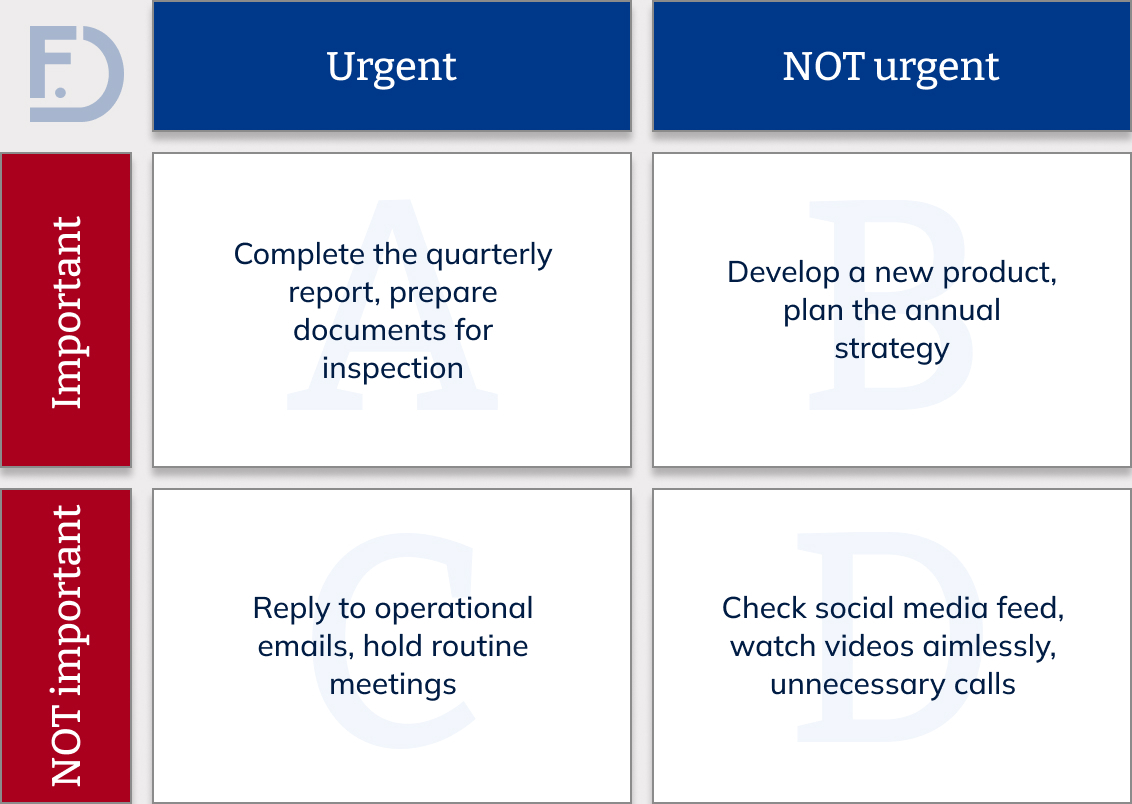All entrepreneurs and managers agree that time is a strategic resource, just like money, reputation, and a professional team. Lost hours cannot be recovered, and a poorly planned day can result in losses, missed deadlines, and professional burnout.
Every day we face dozens of tasks – from urgent matters to unexpected distractions. But how can you learn to manage your time so that it works for you, not against you? Let’s go over the key principles of effective time management.
Every day we face dozens of tasks – from urgent matters to unexpected distractions. But how can you learn to manage your time so that it works for you, not against you? Let’s go over the key principles of effective time management.

1. Prioritize using the Eisenhower matrix
The first step is to learn how to distinguish truly important tasks from secondary ones. The “Eisenhower matrix” method is perfect for this and is used by both large corporations and individual entrepreneurs.
Divide all tasks into four categories and handle them in this order:
Divide all tasks into four categories and handle them in this order:
- Urgent and important (A) – tasks with strict deadlines and high significance.
- Important but not urgent (B) – strategic tasks that impact long-term growth.
- Urgent but not important (C) – routine tasks that can be delegated.
- Neither urgent nor important (D) – time-wasters that bring no value.
How to act depending on the situation?
Strategy 1. Ideal scenario
If you don’t have strict deadlines or emergencies, start with important but not urgent tasks (square B). Then move on to urgent and important ones (A). After that, you will have time left for less significant tasks – first urgent but not important (C), and you can end your day on a lighter note with non-urgent and not important tasks (D).
Strategy 2. Realistic approach
In real life, you will often need to start with urgent and important tasks (A) that cannot be postponed. Then move on to important but not urgent tasks (B), and only after that handle routine and secondary tasks from blocks C and D.
Strategy 3. Emergency mode
When the situation requires immediate action, the priority shifts toward urgency. First, complete urgent and important tasks (A), then urgent but not important tasks (C), followed by important but not urgent (B), and, if you still have time, the tasks from block D.
If you don’t have strict deadlines or emergencies, start with important but not urgent tasks (square B). Then move on to urgent and important ones (A). After that, you will have time left for less significant tasks – first urgent but not important (C), and you can end your day on a lighter note with non-urgent and not important tasks (D).
Strategy 2. Realistic approach
In real life, you will often need to start with urgent and important tasks (A) that cannot be postponed. Then move on to important but not urgent tasks (B), and only after that handle routine and secondary tasks from blocks C and D.
Strategy 3. Emergency mode
When the situation requires immediate action, the priority shifts toward urgency. First, complete urgent and important tasks (A), then urgent but not important tasks (C), followed by important but not urgent (B), and, if you still have time, the tasks from block D.
Example of an Eisenhower matrix for an entrepreneur:

The key goal is to minimize “time-wasters” and free up more time for business development. By “time-wasters” we mean actions and tasks that do not create value and distract you from what really matters: aimless internet browsing, unnecessary meetings, unstructured messaging.
2. Plan your tasks and write them down
Once priorities are set, move on to clear planning. Without it, even the most disciplined people will see their productivity drop.
- Write everything down. Trying to keep tasks in your head is a mistake that overloads your attention and lowers efficiency. Written tasks free up cognitive resources and allow you to focus on your work.
- Make your list visual. Visualization helps you stay focused on daily or weekly goals. Use digital calendars, task boards like Trello or Asana, or a classic notebook – the most important thing is that the tool is convenient and accessible.
- Alternate tasks. Mix complex and intellectual tasks with simpler, routine ones. This will help maintain productivity throughout the day and avoid overload. After completing demanding tasks, take breaks or switch to lighter activities.
- Plan both work and personal tasks. Your calendar or task list should include not only work projects but also time for sports, relaxation, and family and friends. This helps balance your personal and professional life and reduces the risk of burnout.
Consistent planning helps you stay in control even on your busiest days.
3. Optimize processes and delegate
It’s essential to understand which processes require your direct attention and which can be delegated. Without this foundation, any attempt to “do it all” will lead to chaos and loss of control over your schedule.
Optimization helps eliminate routines that slow down business development, while delegation allows you to focus on tasks that truly impact your company’s strategic goals.
Trust your team and delegate tasks that do not require your personal involvement. Delegation strengthens the team, increases their responsibility and motivation, and frees you up to focus on key issues related to business growth and strategic management.
The goal is to free up time for strategic and creative tasks that genuinely move the business forward.
Optimization helps eliminate routines that slow down business development, while delegation allows you to focus on tasks that truly impact your company’s strategic goals.
Trust your team and delegate tasks that do not require your personal involvement. Delegation strengthens the team, increases their responsibility and motivation, and frees you up to focus on key issues related to business growth and strategic management.
- Automate what can be automated: set up automated tasks, email templates, and CRM integrations.
- Group similar tasks – for example, set aside a specific day or a few hours for client communications or document management.
- Delegate tasks that don’t require your direct input – hire assistants, engage freelancers, or involve staff.
The goal is to free up time for strategic and creative tasks that genuinely move the business forward.
If you feel overwhelmed by the workload or need professional support – we are here to assist you at every step.
We offer a full range of financial services, including accounting, auditing, tax and financial consulting, business analysis, and HR solutions. Learn more about how we can support your business.
4. Stay focused and minimize distractions
Today, it is especially difficult to stay focused on a single task – due to constant information noise and multiple parallel processes. A lot of time is wasted on sudden calls, pop-up notifications, multitasking, and frequent task switching. This leads to lack of focus and the feeling of being busy without real productivity.
To remain efficient:
To remain efficient:
- Block time for deep work by turning off notifications.
- Filter all incoming requests – assess their urgency and importance.
- Learn to say “no” to tasks that don’t align with your priorities.
- Write down spontaneous tasks and return to them later.
The more consciously you manage your attention and resources during the day, the higher your productivity will be!
Pro tip: evaluate results and adjust your approach
Once a week, review your performance:
Regular analysis helps you adjust your time management strategy and avoid repeating the same mistakes.
- What did you accomplish?
- Where were the setbacks and distractions?
- Which processes can be improved?
Regular analysis helps you adjust your time management strategy and avoid repeating the same mistakes.
Conclusion
Time management is not just about efficiency; it’s about improving your quality of life. The ability to manage your time allows you to balance business, personal interests, and rest.
Start small – set your priorities, plan your tasks, and gradually optimize your workflow. Within a few weeks, you’ll notice a real difference.
Start small – set your priorities, plan your tasks, and gradually optimize your workflow. Within a few weeks, you’ll notice a real difference.
Let professionals handle your financial and HR tasks so you can focus on growing and developing your business. Our experts will help you build an effective management system, reduce administrative burdens, and ensure full compliance with legal requirements.




